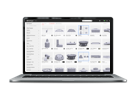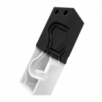Introduction of additive manufacturing
Additive manufacturing (AM), or 3D printing, builds objects layer by layer, eliminating the need for traditional tooling and enabling faster, more flexible production. While 3D printing was originally used for prototyping, it has evolved into a critical manufacturing tool, providing the machine reliability and material strength required for industrial environments. Parts printed with continuous carbon fiber, for example, are as strong as aluminum parts but weigh up to 80% less. And by 3D printing on-site, replacement parts and upgrades can be brought to production or filling lines in hours instead of days or weeks.

How 3D printing increases production and sales
3D printing opens up enormous opportunities for food and beverage manufacturers to reduce their costs and stabilize the supply chain for spare parts. With the on-demand production of customized components, fixtures, and end-of-arm tools, additive manufacturing optimizes production processes, reduces costs, and accelerates production times.
Every minute a packaging line is down reduces profits. On-site additive technologies allow food and beverage manufacturers to resolve production disruptions quickly and cost-effectively. Custom tools and components are much easier to develop and implement with a reliable on-site 3D printing solution, allowing greater flexibility to quickly adapt production lines to customer needs. Instead of waiting for new tools to be manufactured and delivered, they can be designed and printed on-site.
For example, AM-manufactured end-of-arm tools for packaging equipment allow teams to consolidate parts and develop customized end-effector solutions while drastically reducing manufacturing costs and lead times.
Additional features such as vacuum systems, sensor mounts, and cable guides can be incorporated into the design of the parts, minimizing the risk of entanglement or collision with other parts of the work environment.
In a packaging line, custom printing plates are used for various purposes: diverting and sorting, rejecting, loading and feeding, and web changeover. Using AM to manufacture these parts gives continuous improvement teams additional flexibility to optimize performance in hours and days rather than weeks.
Reducing inventory challenges and environmental impacts
Additive manufacturing (AM) offers a practical solution for reducing waste and downtime in food and beverage factories by eliminating the need for physical storage of spare parts. Traditional manufacturing methods often require minimum order quantities for spare parts, resulting in unnecessary costs and space requirements. With AM, parts can be produced on demand, exactly when and where they are needed. This minimizes waiting times for spare parts, reduces storage costs, and lowers environmental impact by reducing unused inventory.
In addition to cost savings, AM also contributes to reducing environmental impact. Because parts are produced only when needed and at the point of use, shipping waste is minimized and sustainability efforts are supported. Furthermore, AM enables designs to be optimized for efficiency, further reducing material waste. This environmentally friendly approach not only meets consumer expectations for responsible production but also enhances brand reputation and competitiveness.
From a financial perspective, the waste reductions achieved through AM directly contribute to increased profits. By eliminating the need for extensive spare parts inventories, manufacturers can invest their resources in more strategic areas. Furthermore, on-demand production of parts minimizes the risk of overstocking or shortages, preventing financial losses due to obsolete inventory or shortages. AM thus optimizes processes and improves resource management, leading to greater profitability for food and beverage manufacturers.
In a time of rapid change in the food and beverage industry, 3D printing offers significant flexibility. By harnessing the power of 3D printing, manufacturers can address challenges, increase production, reduce waste, and improve their agility to ensure a sustainable and profitable future.












Hinterlasse einen Kommentar